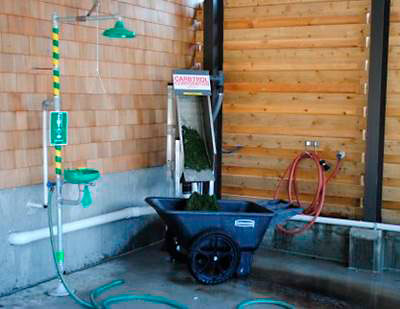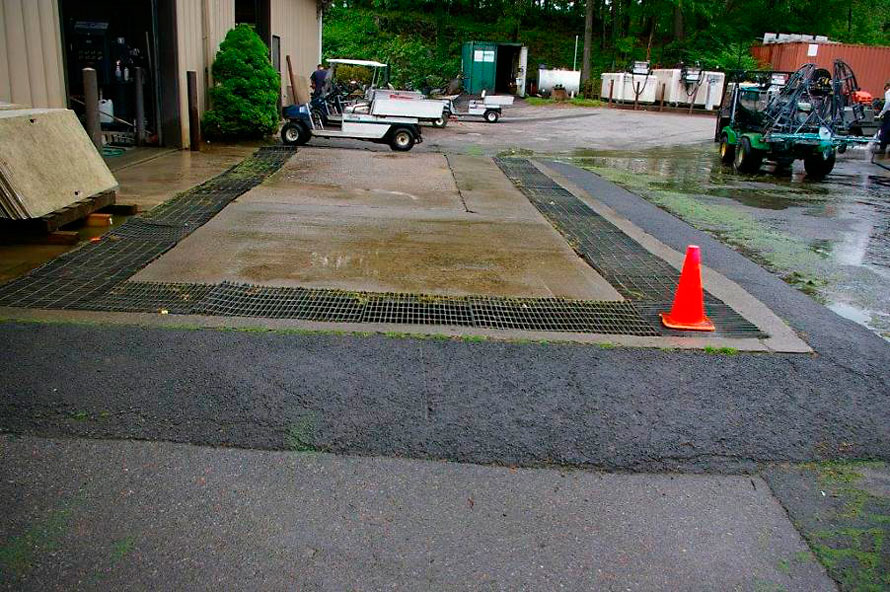A site analysis can identify and assess risk for ground or surface water contamination. The first step is to determine the environmentally sensitive areas, potential release points, and containment strategies currently employed. This analysis should address aspects of storage and handling of chemicals.
NYDEC publishes guidelines relevant for both pesticide and fertilizer storage, as the potential water quality impacts from spills of either are the same, particularly for large containers (greater than 55 gallons) of liquid fertilizers. These are discussed in the Regulatory Framework section of this web site (link “regulatory Framework” to the Regulatory Framework page/Maintenance Facilities section)–Stacey I don’t have a page for this yet. Fertigation often has large tanks for the liquid fertilizer and the storage/containment structure can be large (often part of the irrigation pump house).
Storage
The goal of an ideal storage facility is the safe siting and storage of potential contaminants that ensures a high level of water quality protection (Figure 1). Read more
Mixing and Loading
As with the storage areas, the handling area (mixing and loading) of pesticides and fertilizers should be contained to minimize release of concentrated or diluted pesticides and fertilizers. These compounds should be mixed and loaded on a covered impervious surface properly sized and sloped to capture the maximum potential spill. Read more
Wastewater Handling
The release of organic waste associated with equipment cleaning needs the same level of protection afforded liquid and granular nutrients and pesticides. When debris is removed from equipment, it should not be released into open surface waters or in a location near well heads or shallow groundwater. Figure 7 shows a well designed wash area.

Figure 7. Equipment wash area. Source: Old Oaks County Club.
Integrated Chemical Management
New construction designs should consider integrating storage, mixing, and washing operations in an integrated chemical management system. Buildings and infrastructure are designed to account for the traffic and usage. The resulting design should provide a much better envelope of the operations compared to separately constructed areas. Integrated designs often include fuel storage and filling stations within the same containment areas.
Organic Matter Management
 Figure 10. Clippings removal unit. Source: John J. Genovesi, CGCS, Maidstone Club.
Figure 10. Clippings removal unit. Source: John J. Genovesi, CGCS, Maidstone Club.Nutrient BMPs recommend that clipping be widely redistributed to turf. Research has shown that nitrate levels in leachate increased to as much as 30 mg/L in areas that received four times the normal clippings return. Some clubs elect to collect clippings from fairways and then dump these clippings as yard waste. The accumulation of clippings and other yard wastes such a leaves, tree limbs, and other plant debris can be a substantial source of contamination to surface water and groundwater if placed close to water courses. Read more
 Figure 1. Chemical storage building organization. Source: Robert Alonzi.
Figure 1. Chemical storage building organization. Source: Robert Alonzi.

 Figure 4. Loading fill spray tank from premix. Source: Robert Alonzi.
Figure 4. Loading fill spray tank from premix. Source: Robert Alonzi. Figure 5. Recovery lines and trans pump in the equipment mixing and loading area. Source :Robert Alonzi.
Figure 5. Recovery lines and trans pump in the equipment mixing and loading area. Source :Robert Alonzi. Figure 6. Mixing and loading recovery tanks. Source: Robert Alonzi.
Figure 6. Mixing and loading recovery tanks. Source: Robert Alonzi. Figure 8. Stages of treating wastewater, as shown for an activated carbon adsorption system (EPA, P2 Guide).
Figure 8. Stages of treating wastewater, as shown for an activated carbon adsorption system (EPA, P2 Guide). Figure 9. Microbial system for treating wastewater. Source: Robert Alonzi.
Figure 9. Microbial system for treating wastewater. Source: Robert Alonzi. Figure 11. Prior to washing equipment, removing clippings while over grass (top) or a pad (bottom) with an air hose or prewash reduces the amount of organic debris in the wash water. Source: Robert Alonzi.
Figure 11. Prior to washing equipment, removing clippings while over grass (top) or a pad (bottom) with an air hose or prewash reduces the amount of organic debris in the wash water. Source: Robert Alonzi. Figure 12. Typical equipment wash area with drain. Source: Robert Alonzi.
Figure 12. Typical equipment wash area with drain. Source: Robert Alonzi. Figure 13. A Retrofitted RGF system separates solids in the wash water. Source: Robert Alonzi.
Figure 13. A Retrofitted RGF system separates solids in the wash water. Source: Robert Alonzi. Figure 14. A retrofitted RGF system solid separation pad. Source: Robert Alonzi.
Figure 14. A retrofitted RGF system solid separation pad. Source: Robert Alonzi.